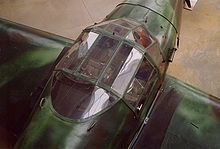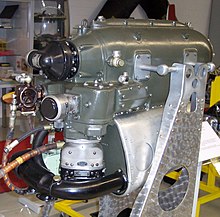Bucker Bü 181
| Bucker Bü 181 | |
|---|---|
 Bücker Bü 181 B Bestmann in the Swedish version as Sk 25 |
|
| Type: | Sports , training and training aircraft |
| Design country: | |
| Manufacturer: | |
| First flight: |
February 1939 |
| Commissioning: |
1940 |
| Production time: |
1940 to at least 1953 |
| Number of pieces: |
more than 3600 |
The Bücker Bü 181 Bestmann was among the globally successful sports, training and training aircraft from the aircraft manufacturer Bücker Flugzeugbau, the one with by far the highest number of units. Bestmann is a term from seafaring.
history
A new concept


The Bü 181 meant a radical change in the habits of initial pilot training. So far, double-deckers , more rarely monoplane, with two open, one behind the other seats for flight instructors and student pilots, who could only communicate with difficulty during the flight by means of previously agreed hand signals, have been used for this purpose. Now Carl Clemens Bücker and his talented Swedish designer, Anders J. Anderson, presented a completely new concept with the Bü 181, which he named Bestmann . In small coastal shipping or fishing, this is the name for a member of the ship's crew who takes over the sea watch instead of the helmsman , but without having the appropriate shipping license.
In a spacious, closed and heatable cabin, trainee pilots and instructors sat next to each other on multiple adjustable and adjustable seats, which made it possible to communicate well. With the good flight characteristics that Bücker takes for granted, the Bü 181 should have had the best prospects, from the Air Force as a new standard training aircraft and replacement for the Focke-Wulf Fw 44 , Heinkel He 72 , and even for the Klemm Kl 35 and the in-house Bücker Bü 131 to be adopted. That was vital, because in contrast to practically all aircraft developments by other companies, for which the Reich Aviation Ministry (RLM) bore the development costs from the outset, Bücker had the full risk for the Bü 181 , as he had with the Bü 131 and the Bü 133 had to bear alone. So he had to be successful with the aircraft in order to be able to recoup the development costs with a larger order from the RLM. But the way there was not that smooth.
The testing
Chief pilot Arthur Benitz had probably flown in the first aircraft, the V1, which bore the D-EPDS registration number, in the last days of February 1939. Only a few days later the chief of the technical office , Lieutenant General Ernst Udet , registered for an inspection and a flight. Even if he obviously had little to complain about in terms of performance and properties, he made a number of complaints, mainly related to the cabin area and the entrance. Above all, it was the two-part entrance doors, of which the lower (sheet metal) part folded forward and the upper glazed part folded up. The headroom also seemed to him to be too little. A fundamental redesign with extremely tight deadlines was therefore necessary, which delayed the completion of the second aircraft planned for May by around two months. This second test machine, the D-ERBV, was managed by the responsible clerk at the Rechlin test center , Dipl.-Ing. Helmut Czolbe , as well as other pilots there from July 29, 1939 on in Rechlin. As the picture shows, the cabin area was significantly changed compared to the V1; it now had one-piece, but still upward-opening entrance doors. Above all, however, the shape and size of the vertical stabilizer did not yet correspond to that of the later production aircraft. Three more test aircraft (V3 to V5) followed, which were tested in Rechlin in every direction. This also included a comparison with the Arado Ar 79 for suitability for training, which came out in favor of the Bü 181. The second competing model, the Klemm Kl 107 , was only being tested by the company at that time and therefore failed.
Start of production

With this, the RLM placed Bücker with a major order and enabled him to expand his factory facilities in Rangsdorf at the expense of the state , where series production of the new A-1 aircraft (still with Hirth HM 504 A-2 engines ) started in mid-1940 . It was converted to B-0 (55 aircraft) and then to B-1 from late 1941. In this version, the Hirth HM 500 engine, which was then used until the end, was already installed, which, like its predecessor, developed 105 hp (77 kW).
Interest abroad
In June 1942, a Bestmann was introduced to Switzerland and registered there with the registration HB-EBI. The AG for Dornierflugzeuge in Altenrhein / Switzerland, which had built most of the Bü 131 and 133 used for their flight training for the Swiss Army under license, was the owner. The aircraft has now been made available to the command of the air and air force for testing. The result did not meet expectations. Despite the best efforts of Bücker, the Swiss preferred their old young men and young masters to the dispatch of the chief pilot Benitz to impressive demonstrations . Towards the end of the war, the Swiss Army took over seven more Bü 181s, all of which were flown in by Germans who had fled to Switzerland and confiscated from former Air Force aircraft.
It was different in Sweden . The Swedish Air Force ( Flygvapnet ) bought a Bü 181 aircraft in 1942 and, after satisfactory testing, acquired the rights to replicate. From March 1944 to 1946 a total of 120 aircraft were built under the designation Sk 25. The machines were built by Hägglund & Söner in Örnsköldsvik . The Swedish Air Force used them between 1944 and 1954. After the end of their military career they were sold to mostly Swedish aviation clubs and private individuals. Several of them came to Germany after 1955. A few still fly today.
Series production is expanded
As a second production facility, the Dutch company Fokker was used from 1942 to build Bü 181. It received an order for 675 B-1 aircraft. The Czech company Zlín , which had built Kl 35 up to then, was added as a further manufacturer in May 1942 . Your order was for 385 aircraft. While Bücker had to deliver 20 machines a month, Zlín was supposed to produce the same number of units with a lead time of half a year. Fokker, on the other hand, was supposed to achieve a constant number of 40 within 10 months, so that at least 80 new aircraft were available every month. The aircraft program 223/1 of August 15, 1943 shows that by March 31 of the year 606 aircraft had been taken over and orders for 2,886 further machines had been placed, which from June in monthly numbers increased to 97 to 99 from the three manufacturers mentioned had to be delivered. What is certain is that the Luftwaffe had 1,318 Bü 181 in operation in January 1944, the number of which had increased to 1,601 by September of that year. While 334,000 flights were made in June and each aircraft was in the air for an average of 102 hours, in September these numbers fell to 94,000 flights with only 29 flying hours per aircraft due to the increasing fuel shortage.
Production of the Bü 181 for the Luftwaffe until January 31, 1945 :
| version | Bucker | Zlín | Fokker | TOTAL |
|---|---|---|---|---|
| A-0 | 7th | 7th | ||
| A-1 | 18th | 18th | ||
| B-0 | 55 | 55 | ||
| B-1 | 542 | 181 | 132 | 855 |
| B-2 | 201 | 244 | 445 | |
| C-1 | 275 | 275 | ||
| C-2 | 1 | 404 | 332 | 737 |
| C-3 | 289 | 289 | ||
| TOTAL | 1187 | 786 | 708 | 2681 |
In February and March 1945 about 50–60 Bü 181 were built by Zlín and Bücker. It can be assumed that some aircraft also rolled off the assembly line in April 1945. This means that around 2,750 Bü 181 were built during the war.

After the end of the war, the aircraft was only manufactured in Zlín as the Z-18 or C-6 (in Czech, Cvičná letadla for training aircraft ). When the German engines were exhausted, Czech ones were installed. With the Zlín Toma 4 (110 hp) the aircraft was now called the Z-281 or C-206 and with the Walter Minor 4-III (105 hp) Z-381 or C-106. From 1945 to 1946 71 Z-181 aircraft were built, 79 Z-281 aircraft from 1946 to 1949 and 315 Z-381 aircraft from 1947 to 1953, totaling 465 aircraft.
But that was not the end of the career of the “best man”. In Egypt , the company Heliopolis Air Works acquired the construction documents in the 1950s and developed its own version under the name Gomhouria , which was powered by a 6-cylinder boxer engine Continental O-300 A with 147 PS (108 kW) and also in has been exported to various Middle East countries.
Technical specifications
| Parameter | Data Bü 181A |
|---|---|
| crew | 1-2 |
| length | 7.85 m |
| span | 10.60 m |
| height | 2.05 m |
| Wing area | 13.50 m² |
| Wing extension | 8.3 |
| Empty mass | 480 kg |
| Max. Takeoff mass | 750 kg |
| Top speed | 215 km / h |
| Service ceiling | 5000 m |
| Max. Operational range | 800 km |
| Engine | an in-line engine Hirth HM 504, 105 PS (77 kW) |
See also
literature
- Peter W. Cohausz: Bücker Bü 181 "Bestmann" . In: Flugzeug Classic . No. 11 , 2005, ISSN 1617-0725 , p. 76-78 .
- Philipp Prinzing: Bücker's best. Bucker Bü 181 . In: Klassiker der Luftfahrt , 03/2019, ISSN 1860-0654 , pp. 12-17.
Web links
- Bücker 181 Bestmann D-EQXE, in the Quax-Förderverein für historical Fluggerät e. V. ( Memento of October 8, 2011 in the Internet Archive )
- Heliopolis Gomhouria Mk6 D-EEXE
Individual evidence
- ↑ Documents from the Federal Archives / Military Archives Freiburg



